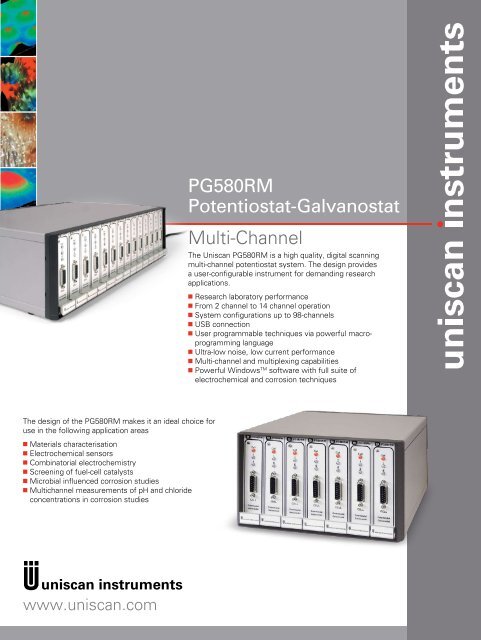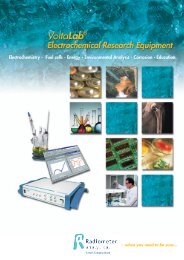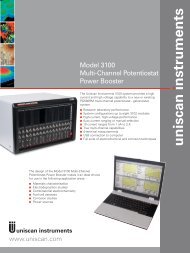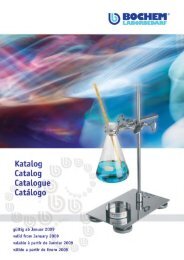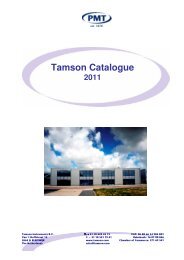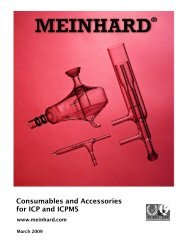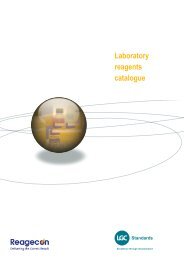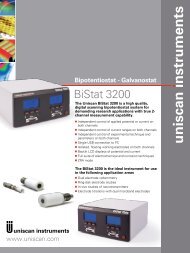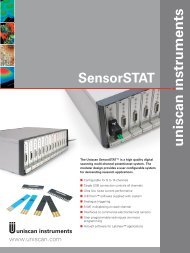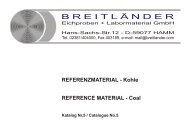PG580RM Potentiostat-Galvanostat - Andreescu Labor & Soft
PG580RM Potentiostat-Galvanostat - Andreescu Labor & Soft
PG580RM Potentiostat-Galvanostat - Andreescu Labor & Soft
You also want an ePaper? Increase the reach of your titles
YUMPU automatically turns print PDFs into web optimized ePapers that Google loves.
<strong>PG580RM</strong><br />
<strong>Potentiostat</strong>-<strong>Galvanostat</strong><br />
Multi-Channel<br />
The Uniscan <strong>PG580RM</strong> is a high quality, digital scanning<br />
multi-channel potentiostat system. The design provides<br />
a user-configurable instrument for demanding research<br />
applications.<br />
Research laboratory performance<br />
From 2 channel to 14 channel operation<br />
System configurations up to 98-channels<br />
USB connection<br />
User programmable techniques via powerful macroprogramming<br />
language<br />
Ultra-low noise, low current performance<br />
Multi-channel and multiplexing capabilities<br />
Powerful Windows TM software with full suite of<br />
electrochemical and corrosion techniques<br />
The design of the <strong>PG580RM</strong> makes it an ideal choice for<br />
use in the following application areas<br />
Materials characterisation<br />
Electrochemical sensors<br />
Combinatorial electrochemistry<br />
Screening of fuel-cell catalysts<br />
Microbial influenced corrosion studies<br />
Multichannel measurements of pH and chloride<br />
concentrations in corrosion studies<br />
uniscan instruments<br />
www.uniscan.com
Features<br />
High throughput combinatorial<br />
micro electrochemistry<br />
Electrosynthesis is an effective way to produce<br />
chemical transformations by utilising redox reactions.<br />
Libraries of specific ions can be generated in the<br />
wells of microtitre plates by potentiostatic electrolysis<br />
under the computer control of the <strong>PG580RM</strong><br />
multichannel electrochemical system. As an online<br />
technique the multi-channel system allows a very fast<br />
assessment of the redox state during the electrolysis.<br />
The <strong>PG580RM</strong> has unique features which makes<br />
it an ideal choice where high sample throughput is<br />
a requirement. The <strong>PG580RM</strong>’s modular concept<br />
means it can be configured to create a user defined<br />
system from a 2-channel up to a 14-channel system<br />
within the same chassis. By connecting a 14-<br />
channel chassis to other RM units an extended<br />
system is created. A ninety-eight sensor array can<br />
be individually addressed by ‘chaining’ together<br />
seven 14-channel systems. The software treats the<br />
combined units as one system.<br />
Multiplexing Capabilities<br />
Where high throughput is not essential but high<br />
productivity needs to be achieved the user can make<br />
use of the multiplexing capabilities of the RM system.<br />
Each individual channel can, with the appropriate<br />
cable set, sequentially address up to five working<br />
electrodes making a cost effective solution to working<br />
with multiple electrodes.<br />
The system can also be configured to have one<br />
counter electrode, one reference electrode but<br />
multiple working electrodes. This feature makes the<br />
instrument suitable for applications such as multipoint<br />
corrosion monitoring applications or fundamental<br />
research of potential variations along a polarised ribbon<br />
electrode.<br />
Autosequencing<br />
The software permits auto-sequencing of experiments.<br />
Experiment chains such as E CORR<br />
vs. Time, LPR, Tafel<br />
and Potentiodynamic scans can be accomplished<br />
without the need to manually start the next<br />
experiment. You can also include loops so that a<br />
group of experiments is repeated a number of times.<br />
Data is automatically transferred to the computer for<br />
subsequent analysis.<br />
Analogue Triggering<br />
Capability<br />
The <strong>PG580RM</strong> modules have a real time analogue<br />
triggering facility. The triggering can be configured to<br />
execute on high or low thresholds of current, potential<br />
or auxiliary voltage. The triggering provides sub<br />
millisecond timing accuracy and can offer both pre and<br />
post trigger data as required.<br />
A typical application would be an electrochemical<br />
sensor where a small initial potential is set between<br />
the electrodes to detect the point when an analyte<br />
comes into contact with the electrodes. The trigger<br />
facility allows the instrument to apply waveforms and<br />
measure with precision timing relative to such an<br />
event.<br />
2
<strong>Soft</strong>ware<br />
The software supplied with the<br />
<strong>PG580RM</strong>, either UiEChem TM or<br />
UiECorr TM , is a comprehensive<br />
and fully featured package which<br />
encompasses a wide selection<br />
of standard electrochemical<br />
techniques. All this is combined<br />
with an easy-to-use graphics<br />
interface. After a technique<br />
has been selected a waveform diagram is displayed<br />
showing the structure of the experiment. At the<br />
same time the user can enter in the experimental<br />
parameters, set the sampling rate, number of cycles<br />
and current autoranging. The software automatically<br />
configures itself to the number of potentiostat<br />
channels installed in the <strong>PG580RM</strong> unit.<br />
A standard graphics display is provided for each<br />
technique and we have added the ability for the user<br />
to define their preferred format for each technique<br />
from a simple template. A right-mouse click on the<br />
plot gives access to the graph properties. From here<br />
you can choose from a selection of line sizes, colours<br />
and styles and overlay multiple data files.<br />
Advanced waveform generation<br />
The <strong>PG580RM</strong> modules are capable of generating<br />
complex and repetitive waveforms with precision timing.<br />
The instrument has a sequenced waveform generator<br />
which generates waveforms based on a sequence of<br />
steps. Each step may comprise a waveform which<br />
includes pulses, linear sweeps and arbitrary waves.<br />
The waveform generator has a timing resolution of<br />
125 microseconds and will seamlessly sequence<br />
from one step to the next. Other events such as Cell<br />
On/Off and WE number can also be programmed<br />
into a sequence. The sequencing supports loops and<br />
advanced functionality such as analogue triggering. The<br />
sequencing is used to create the standard experiments<br />
in the UiEChem TM or UiECorr TM software packages and<br />
both these applications support macro programming<br />
for unique experiments. The sequencing facilities may<br />
also be used in your own programming language via the<br />
optional ActiveX ® control.<br />
A configurable autosequencing routine provides an easy<br />
solution to starting and stopping long term experiments.<br />
Extended monitoring of the corrosion state of metals by<br />
LPR or sensors by chronoamperometry is now a ‘handsoff’<br />
operation.<br />
3
Specifications<br />
General<br />
Slots taken<br />
2 minimum in base unit<br />
Cell connections<br />
2 or 3 and earth<br />
Floating measurements<br />
Yes with isolation option<br />
Maximum ADC sample rate<br />
100 kHz<br />
Maximum time record<br />
Unlimited*<br />
Scan rate<br />
1 µV/s to 10 V/s<br />
Minimum pulse duration 125 µs<br />
*Subject to max 131k data points.<br />
Counter Electrode<br />
Voltage polarisation range<br />
Current polarisation range<br />
Maximum compliance<br />
Rise time<br />
± 2 V with factory option to<br />
± 8 V<br />
±20 mA<br />
±8 V<br />
1 V/µsec into 1 kΩ<br />
Reference Inputs<br />
Connections<br />
Differential Electrometer<br />
Maximum voltage measurement<br />
± 2 V with factory option to<br />
± 8 V<br />
Maximum resolution 61 µV<br />
Input impedance<br />
10 11 Ω II 5pF<br />
Input bias current<br />


